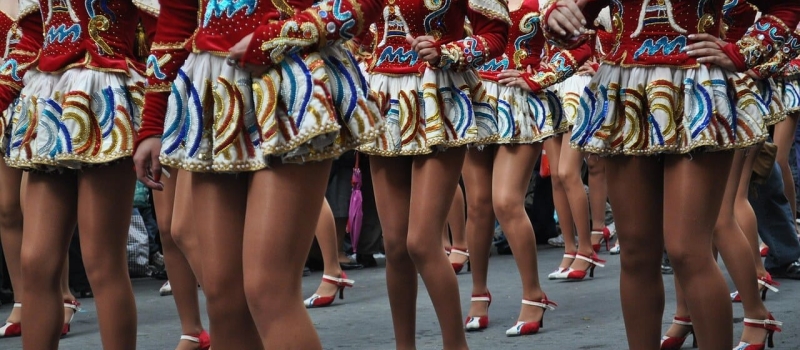Bolivia’s Carnival in Oruro
Carnival is celebrated in many places around the world, but the fascinating carnival of Oruro in Bolivia is so culturally important that it has recognized as a “Masterpiece of the Oral and Intangible Heritage of Humanity” by UNESCO.
Nestled in the heart of Bolivia, the city of Oruro transforms each year into a vibrant spectacle of color, music, and dance during its world-renowned Carnival. The Carnival of Oruro is a must-visit event for anyone looking to immerse themselves in rich authentic cultural traditions and boundless festive joy.
🎊 The Carnival of Oruro, Bolivia, is a vibrant religious and cultural festival featuring parades and open-air performances. The costumes and masks are incredibly ornate and expensive, meticulously handmade well in advance. Dancers prepare for months leading up to the grand parade.
Join us to discover more about the magic of Bolivia’s carnival in Oruro!
A Festival Rooted in History and Myth
The Oruro Carnival’s origins are deeply intertwined with indigenous traditions and Spanish colonial influences. Tracing back over two centuries, it began as an indigenous festival and is now celebrated in honor of the Virgin of Candelaria, also known as the Virgin of Socavón, the patroness of miners. According to legend, the festival began with a miraculous event when a statue of the Virgin Mary appeared in a local mine, leading to the fusion of indigenous and Christian rituals into today’s grand Oruro Carnival.
The Heart of the Celebration: The Diablada
👹👼🏻 At the core of the Carnival is the spectacular “Diablada” or Dance of the Devils, the most prominent traditional dance of the Oruro Carnival in Bolivia 🇧🇴. This intricate performance held in honor of the Virgin de Socavón or Virgen de la Candelaria, symbolizes the battle between good and evil and the defeat of the seven deadly sins. Recognized by UNESCO as a masterpiece of the Oral and Intangible Heritage of Humanity, the Diablada features performers dressed as demons, angels, and various mythological creatures. Dancers in elaborate devil costumes with colorful masks, large bulging eyes, sharp teeth, and twisted horns move to the rhythm of traditional Andean music, creating a mesmerizing visual and auditory experience. The Archangel Michael leads angelic dancers adorned in bright, gold-feathered outfits.
The dance is a blending of Catholicism brought from Spain and Andean ceremonies. The dancers dance non-stop for 20 hours wearing the most colorful costumes.
More Than Just a Parade
While the Diablada is the highlight, the Carnival parade offers much more. Over 48 groups, comprising thousands of dancers and musicians, parade through the streets of Oruro, showcasing a variety of traditional dances from across Bolivia. These include the Morenada, Caporales, Tinku, Tobas and many others, each with its own distinct history and cultural significance. The costumes are works of art in themselves, often taking months to create, reflecting the pride and dedication of the participants.
A Spiritual Journey
For many, the Oruro Carnival is not just a celebration but a pilgrimage. The event culminates with the main event on Saturday (of Carnival): the “Peregrinación de la Virgen de la Candelaria o Virgen del Socavón” (pilgrimage to the Socavón sanctuary). This grand parade starts at 7:00 am and lasts for 20 hours, featuring thousands of folkloric dancers in traditional costumes. Dancers and spectators alike pay their respects to the Virgin. This blend of festivity and spirituality gives the Carnival a unique and profound atmosphere, setting it apart from other celebrations around the world.
🤩The Pilgrimage to the Socavón Sanctuary is the main parade and features around 48 groups that are made up of 20,000 dancers, 150 bands and 10,000 musicians.🎵🎶
This incredible parade is why the Carnival of Oruro is so famous and attracts people from all around the world.
Practical Information for Travelers:
The Oruro Carnival typically takes place in February or March, aligning with the pre-Lenten season. If you’re planning to attend, here are a few tips:
1. Book Early: Accommodation in Oruro fills up quickly during Carnival season, so it’s wise to book your stay well in advance. If you’d like assistance with travel arrangements, check out our tailor-made tours. We’d be happy to help!
2. Dress Comfortably: While the high-altitude Andean climate can be cool, the excitement and crowds can make the experience quite warm, so dress in layers.
3. Join the Festivities: Don’t just watch from the sidelines. Engage with the local culture, try traditional foods, and maybe even learn a dance or two.
4. Respect the Customs: 👀Remember that this is a deeply cultural and spiritual event for many Bolivians. Respect the traditions and the local people’s way of celebrating.
Getting there
Experiencing the Oruro Carnival is like stepping into a living tapestry of Bolivia’s cultural heritage. Whether you’re captivated by the dramatic dances, the pulsating music, or the vibrant costumes, the Carnival offers a once-in-a-lifetime experience that celebrates the spirit of Bolivia.
Look up the Carnival dates for the next few years.
So pack your bags, bring your sense of adventure, and get ready to be part of one of the world’s most extraordinary festivals.
You can also combine the carnival experience with a visit to Salar de Uyuni and or other destinations in Bolivia. Ruta Verde Tours is known for traveling with comfort, ease and safety. Reach out to us and get a tailor-made travel experience that cover your specific preferences.





